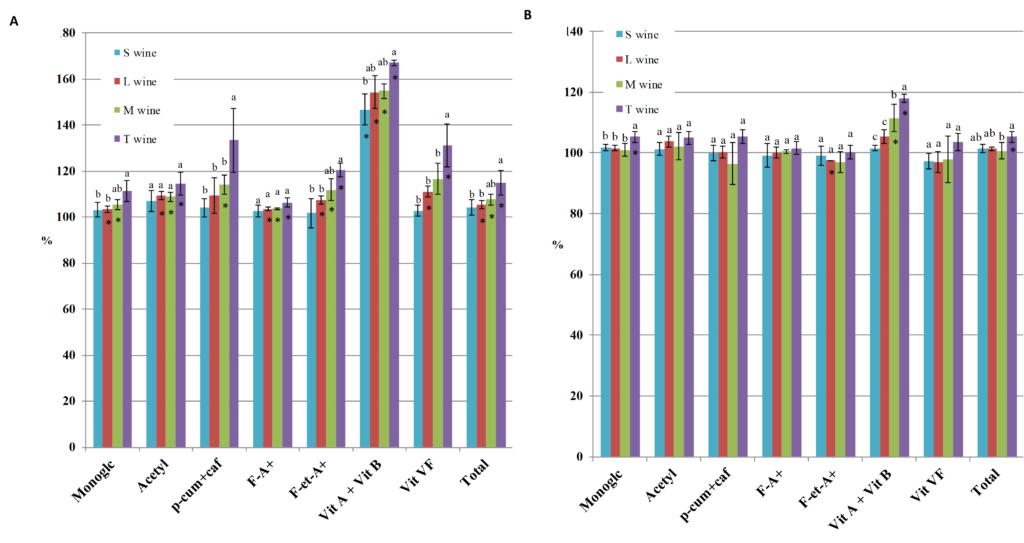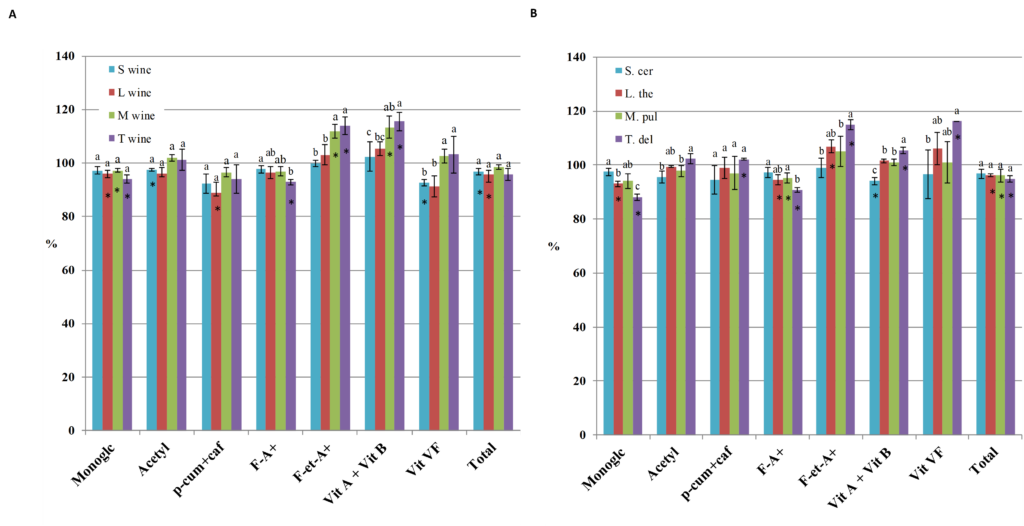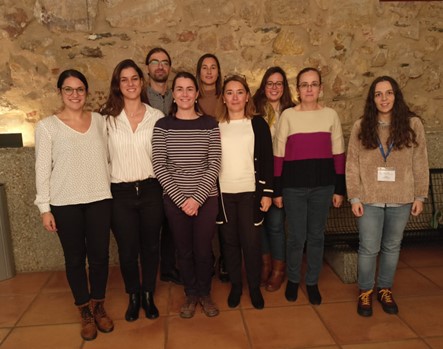By María Oyón-Ardoiz, Elvira Manjón, María Teresa Escribano-Bailón, Ignacio García-Estévez
Global climate change is having a negative impact in grape and wine quality, representing a serious problem for many winegrowing regions, particularly, for the Southern European regions (Venios et al., 2020). In this sense, the increasing temperatures can favor the accumulation of sugars and slow down the biosynthesis of anthocyanins, leading to an imbalance of these two compounds in grapes and consequently to wines with poor and/or unstable color (Sadras and Moran, 2012).
The addition to wine of MPs could contribute to mitigate this problem since some studies have shown a protective effect of MPs on wine color (Alcalde-Eon et al., 2014 and 2019). However, the role of MPs in wine color is not well established yet and some authors have shown that MPs can provoke the precipitation of wine pigments and a loss in stable color (Guadalupe et al., 2007 and 2008). MPs released by yeast are one of the most abundant polysaccharides of red wine (Guadalupe et al., 2014). In the market, many MP preparations indicated for the modulation of wine color can be found. These commercial preparations are obtained from Saccharomyces cerevisiae, the main wine yeast. However, in grape musts other non-Saccharomyces yeasts are naturally present, but the potential oenological use of the MPs derived from these yeasts has never been evaluated. Consequently, in this study, MP-rich extracts from Saccharomyces cerevisiae and three non-Saccharomyces yeasts (Lachancea thermotolerans, Metschnikowia pulcherrima and Torulaspora delbrueckii) were obtained and characterized. The characterization of the MP extracts revealed that the MPs characteristics (i.e. size, protein content and monosaccharide composition) were dependent on the yeast of origin.
The four MP-rich extracts were added to a Tempranillo red wine in order to evaluate their effect on wine color and pigment composition. Wine samples were submitted to a treatment with cold (to evaluate the effect of the extracts in pigment colloidal stability) and a treatment at room temperature (to evaluate the effect of the extracts on the evolution of the coloring matter during an oxidative process). Two sampling points were established in both treatments: C1 (4 days) and C2 (11 days) for the treatment with cold; and R1 (7 days) and R2 (18 days) for the treatment at room temperature. In the four sampling points, color and pigment composition modifications were evaluated.
After a short treatment with cold (C1), total pigment content was significantly higher in the wines treated with the MP-rich extracts (Figure 1A) suggesting that the addition of the extracts could increase the colloidal stability of the coloring matter. It is important to note that the extract obtained from T. delbrueckii was the most effective for the stabilization of all types of pigments, whereas the extract from S. cerevisiae had the least effect. The observed differences in the effect of the extracts seemed to be dependent on the yeast of origin and could be related to differences in the composition and structure of the MPs. On the other hand, the positive effect of the extracts seemed to diminish with the prolongation in the time of application of cold (sampling point C2) (Figure 1B), indicating that the extracts were less effective against a prolonged colloidal destabilization.

Figure 1. Percentage (%) of each pigment group with respect to the control at C1 (A) and C2 (B) sampling points. Monoglc: anthocyanin monoglucosides; Acetyl: acetylated anthocyanins; p-coum+caf: p-coumaroylated and caffeoylated anthocyanins; F-A+: flavanol-anthocyanin direct condensation products; F-et-A+: flavanol-anthocyanin acetaldehyde-mediated condensation products; Vit A+Vit B: A-type and B-type vitisins; Vit VF: vinylphenol-type vitisins. Different letters indicate significant differences (p<0.05) among added samples. Significant differences (p<0.05) between the control and the corresponding added samples are indicated with an asterisk.
Regarding the treatment at room temperature, the addition of the MP-rich extracts led to a lesser content of pigments in both sampling points (R1 and R2) (Figure 2). In this treatment, it is important to highlight the modifications in wine pigment composition produced upon the addition of T. delbrueckii extract. In this sense, the addition of this extract led to a reduction in grape native pigments (specially, anthocyanins monoglucoside) that was accompanied by an increase in the content of derivative pigments (flavanol-anthocyanin acetaldehyde-mediated condensation products, A type and B type vitisins and vinylphenol-type vitisins) (Figure 2A). Given that derivative pigments are chemically more stable than anthocyanins, the addition of T. delbrueckii extract could also result in a greater chemical stability of the coloring matter.

Figure 2. Percentage (%) of each pigment group with respect to the control at R1 (A) and R2 (B) sampling points. Monoglc: anthocyanin monoglucosides; Acetyl: acetylated anthocyanins; p-coum+caf: p-coumaroylated and caffeoylated anthocyanins; F-A+: flavanol-anthocyanin direct condensation products; F-et-A+: flavanol-anthocyanin acetaldehyde-mediated condensation products; Vit A+Vit B: A-type and B-type vitisins; Vit VF: vinylphenol-type vitisins. Different letters indicate significant differences (p<0.05) among added samples. Significant differences (p<0.05) between the control and the added samples are indicated with an asterisk.
In summary, the effect of the MP-rich extracts seemed to depend on their protein content, monosaccharide composition and MP size, being these characteristics conditioned by the yeast species. The greatest contribution of T. delbrueckii extract to the colloidal and chemical stability of wine pigments could open the possibility to the use of non-Saccharomyces yeasts as a new source of MPs of oenological interest. Read more at: https://doi.org/10.1016/j.lwt.2022.114219

Research Group (Left to right): Dr. Elvira Manjón Pérez, Diana Marelys Bosch Crespo, Dr. Ignacio García Estévez, Dr. Cristina Alcalde Eon, Rebeca Ferreras Charro, Dr. M. Teresa Escribano Bailón, Bárbara Torres Rochera, Dr. Montserrat Dueñas Patón, María Oyón Ardoíz: Food Quality Research Team – Grupo de Investigación en Polifenoles (GIP) – Department of Analytical Chemistry, Nutrition and Food Sciences – University of Salamanca (USAL), Salamanca, Spain. Our research projects are focused on the study of the role of phenolic compounds on quality and stability of food products. The main research topic is related to the impact of the phenolic maturity of red grapes on sensory quality of red wines, namely on color and astringency properties. Recent works aimed to go deepen on the study of the molecular mechanisms for astringency development. Furthermore, our studies are also related to the revalorization of by-products from the oenological industry as relevant sources of different biomolecules (polysaccharides, mannoproteins…) with interesting technological properties.
References
- Alcalde-Eon, C., García-Estévez, I., Puente, V., Rivas-Gonzalo, J. C., & Escribano-Bailón, M. T. (2014). Color stabilization of red wines. A chemical and colloidal approach. J. Agri. Food Chem., 62(29), 6984–6994. https://doi.org/10.1021/jf4055825
- Alcalde-Eon, C., Pérez-Mestre, C., Ferreras-Charro, R., Rivero, F. J., Heredia, F. J., & Escribano-Bailón, M. T. (2019). Addition of mannoproteins and/or seeds during winemaking and their effects on pigment composition and color stability. J. Agri. Food Chem., 67(14), 4031–4042. https://doi.org/10.1021/acs.jafc.8b06922
- Guadalupe, Z., & Ayestarán, B. (2008). Effect of commercial mannoprotein addition on polysaccharide, polyphenolic, and color composition in red wines. J. Agri. Food Chem., 56(19), 9022–9029. https://doi.org/10.1021/jf801535k
- Guadalupe, Z., Palacios, A., & Ayestarán, B. (2007). Maceration enzymes and mannoproteins: A possible strategy to increase colloidal stability and color extraction in red wines. J. Agri. Food Chem., 55(12), 4854–4862. https://doi.org/10.1021/jf063585a
- Sadras, V. O., & Moran, M. A. (2012). Elevated temperature decouples anthocyanins and sugars in berries of Shiraz and Cabernet Franc. Aust. J. Grape Wine Res., 18(2), 115–122. https://doi.org/10.1111/j.1755-0238.2012.00180.x
- Venios, X., Korkas, E., Nisiotou, A., & Banilas, G. (2020). Grapevine responses to heat stress and global warming. Plants, 9(12), 1754. https://doi.org/10.3390/plants9121754

